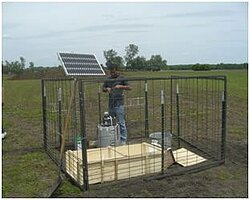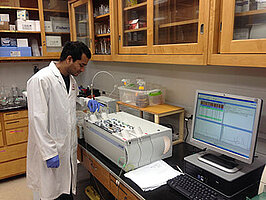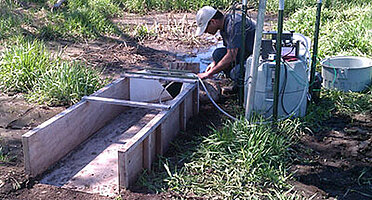Vegetative Filter Strips: A Best Management Practice (BMP) for feedlot runoff pollution control in North Dakota

Atikur Rahman is a Ph.D. student in the Department of Agricultural and Biosystems Engineering at North Dakota State University. He obtained his Master of Science degree in Irrigation and Water Management in 2007 and Bachelor of Science degree in Agricultural Engineering in 2005 from Bangladesh Agricultural University, Bangladesh. His research focuses on runoff pollution control from feedlot using vegetative filter strips (VFS).
Email: atikur.rahman@ndsu.edu
Cell Phone: 701-205-8403
Fellow: Atikur Rahman
Advisor: Shafiqur Rahman, Ph.D., Assistant Professor, Department of Agricultural and Biosystems Engineering, North Dakota State University
Degree Progress: Ph.D. in Agricultural and Biosystems Engineering, expected graduation spring 2013
Vegetative Filter Strips: A Best Management Practice (BMP) for feedlot runoff pollution control in North Dakota
Animal agriculture contributes large portions of surface water pollution through runoff. With the increasing numbers of livestock operations and land application of manure, surface water pollution would likely to increase due to runoff. For example, runoff from feedlots may carry significant amount of manure borne nutrients (e.g., nitrogen and phosphorous) to surface water and may cause eutrophication. In North Dakota, significant portion of water is either threatened or does not support the aquatic life use due to excessive nutrient loadings.
As to protect downstream water from feedlot runoff pollution, VFS are widely used and are increasingly viewed as an alternative technology to containment structures for improving the quality of downstream surface water. Many studies have demonstrated the effectiveness of VFSs for reducing nutrients and solids from feedlot runoff. VFS performance, however, depends on soil type, vegetation type, filter strip dimensions, hydrology, and pollutant types (soluble or particulate bound), and these factors vary significantly from region to region. Due to different cropping management and climatic patterns, VFS design criteria developed and used elsewhere to minimize feedlot runoff pollution are not directly transferrable to North Dakota farming and management conditions. Therefore, to optimize design, VFS performance needs to be evaluated based on local and regional climatic condition and design criteria.
Although removal of sediment and sediment bound pollutants by VFSs is well documented, but soluble pollutants are not effectively removed by VFSs. Despite the poor performance of VFSs in abating the soluble nutrients transport, limited initiatives have been taken to address this concern. It is observed that solubility of nitrogen (N), phosphorus (P), and other compounds are largely affected by soil pH condition. Thus, changing pH of soil may influence the solubility and removal of nitrogen and phosphorous contained in runoff when they flow through a VFS system. However, very limited or no information is available on the impact of pH changes on the VFS performance.
Project Objectives:
The main objective of the proposed research is to recommend best management practices for minimizing feedlot runoff pollution in North Dakota. The specific objectives are:
- To evaluate the performance of vegetative filter strips installed at the downslope end of feedlots,
- To study the effect of pH within the VFS in reducing manure borne soluble nutrients in runoff, and
- To recommend practices for vegetative filter strip design and management.
Progress:
This research is on-going. Significant amount of runoff samples have been collection in year 2010 and 2011. Feedlot runoff samples collection will continue in 2012. Besides feedlot runoff samples collection, two batches of lab experiments have been finished in 2011 and another batch of lab experiment will be done in 2012. Sample analyses and data processing are ongoing. Based on the research progress, either manuscript has been accepted for publication or they are under review as listed in research outcome section. Also, research findings have been presented in the professional meetings.
Benefits and Significance:
This study will provide useful information on VFS performance, which could be used to modify the existing design used under North Dakota farming and management practices and to create awareness to producers and stakeholders about the benefits of VFS. Thus, water pollution reduction at lower cost would be possible. Moreover, it is expected that the study result would recommend techniques about minimizing soluble nutrient transports through VFS. A VFS design recommendations will be made based on overall study results, which will befit under North Dakota climatic conditions and management practices.
Research Outcomes:
Rahman, Atikur and Shafiqur Rahman. 2012. Effect of pH in vegetative filter strips in reducing manure borne soluble nutrients in runoff. Abstract Accepted for the presentation in the annual international conference of American Society of Agricultural and Biological Engineers (ASABE), August 2012, Dallas, Texas.
Rahman, Atikur, Shafiqur Rahman, and Larry Cihacek. 2011. Efficacy of vegetative filter strips to minimize solids and nutrients from feedlot runoff. CIGR Journal (In Review).
Cemek, Bilal, Shafiqur Rahman, and Atikur Rahman. 2011. Prediction of nutrients concentration in runoff from beef cattle feedlot using artificial neural network. Environmental Engineering and Management Journal (accepted).
Rahman, Atikur and Shafiqur Rahman. 2011. Efficacy of vegetative filter strips to minimize solids and nutrients from feedlot runoff. ASABE Paper Number 1110688. ASABE, St. Joseph, Mich.
Rahman, Shafiqur, Atikur Rahman, and Ron Wiederholt. 2011. Vegetative filter Strips reduce feedlot runoff pollutants. NDSU Extension Publication No. NM1555. North Dakota State University Extension Service.



Shafiqur Rahman
AES Ag & Biosystems Eng
Office: Morrill 206
Phone: 701-231-7336
Email: s.rahman@ndsu.edu


